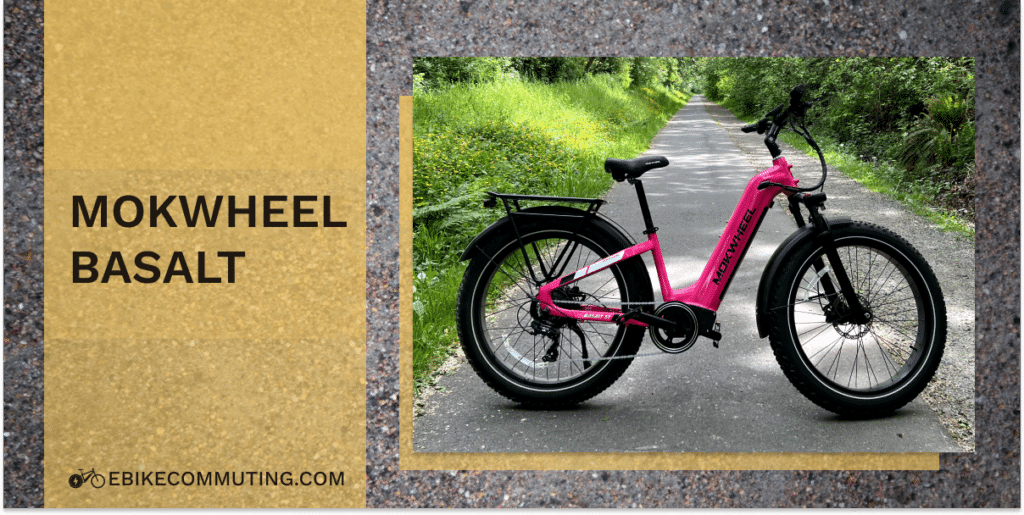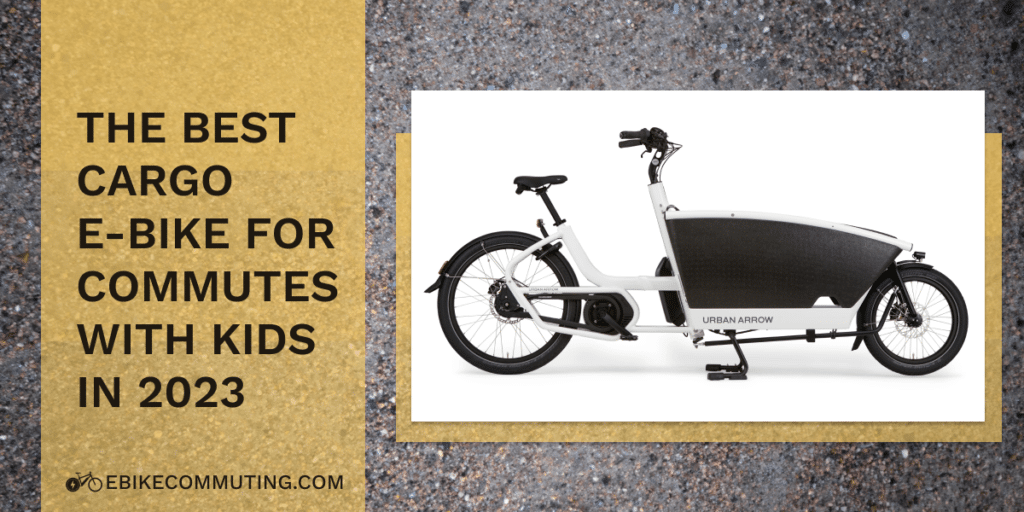👋🏻 We help our readers find the best quality e-bikes and gear to fit their needs. We strive to physically test the products that we recommend. When you buy through our links, we may earn a commission.
Today, we’re reviewing the Mokwheel Basalt ST e-bike. I’ve been riding this fat tire e-bike for the past month in a variety of conditions. In this post I’ll walk you through the things that I really like about the Mokwheel Basalt ST and a few areas where it falls short.
Table of contents
Key e-bike details
Basics
- Price: $2,199
- Class: 3
- Max Speed: 28 mph
- Estimated Range: 60 to 80 miles
- Weight: 68 lbs
Motor & Electronics
- Motor: 48V 750W Brushless Rear Hub Motor
- Torque: 90 Nm
- Motor location: Rear hub
- Battery: UL Samsung 48V 19.6Ah
- PAS Sensor: Torque
- Throttle: Yes, Thumb Throttle
- Display: LED
Components
- Brakes: Tektro HD-E350 hydraulic disc
- Drivetrain: Shimano 7-Speed
- Belt Drive: No
- Tires: 26×4.0″ Puncture Resistant Fat Tire
Misc
- Recommended Rider Height:
- Large : 5’6″ – 6’8″
- Normal: 5’2″ – 6’4″
*note: sizing was off, see my full review below
- Max Rider Weight: not listed
- Payload Capacity: 350 lbs
- Safety Certification: UL 2271

What we like about it
- Motor & Torque: The powerful 750-watt rear hub motor and 90 Nm of torque provide excellent acceleration and make it great for climbing hills.
- Torque sensor: A torque sensor helps the Basalt ST deliver power evenly and naturally, offering a more natural riding experience than a Cadence sensor.
- Big tires: The 4” wide tires handled various conditions excellently, providing stability and comfort on both wet and dry gravel, and wet and dry pavement.
- Throttle: The throttle provided an extra boost when getting up to speed from a standstill.
- 7-Speeds: The Shimano 7-speed gear system performed well and offered a welcome range on hills.
- Long range: The large battery capacity means it can hit ranges of 60 to 80 miles.
- Smooth ride: The front suspension, big tires, and plush seat make for a very smooth and comfortable ride.
Where it falls short
- Attention to detail: The Basalt ST is mislabeled as a class 2, even though it should be classified as a class 3 due to its throttle providing power up to 28 mph. There were discrepancies between the instructions in the manual and the accompanying photos. Also, the color is called “Plum” on the website, but appears to be very pink to me.
- Odd Sizing: I found the recommended rider heights for their sizes to not be accurate, the “Normal” which is advertised as up to 6’4″ was too small for me at 6’2″.
- Battery errors: A few times while riding I encountered a battery error where the motor and display unexpectedly turned off, indicating a “battery error” on the display. It would remain off for about 10 seconds and then start back up as if nothing happened. It wasn’t frequent, but something that gives me pause.
- No bell: Mokwheel opted for a horn rather than a bell, but I found the horn to be too startling to pedestrians on the multi-use paths.
- Display: The display, while packed with information, lacks a remaining range estimation which could help manage battery use.
Watch our Youtube review
Our Test Results
Hill Climb Test

Our hill climb involves taking the e-bike up the 65th Ave hill in Seattle. This hill climb segment spans 0.5 miles and has an elevation gain of 200 feet. With an average grade of 8.6% and a maximum grade of 11.4%. The steepest part is near the top, adding a nice kicker to the end. We ride it at a comfortable pace as if this was just another hill on our daily commute, we aren’t trying to kill ourselves and take a KOM.
Tyler (at 185’ish pounds) completed the segment on the Mokwheel Basalt ST in 2 minutes and 38 seconds. That’s an average speed of 9.8 mph.
Cadence vs Speed Test
This test is designed to determine the pedaling speed required to reach specific velocities. The test is carried out twice on a flat road. We record the average cadence necessary to maintain speeds of 15 mph, 20 mph, and 25 mph for five seconds, using the highest level of pedal assistance. The test is conducted twice, and the results are averaged.

| PAS Level | 15 mph | 20 mph | 25 mph |
| Level 5 (highest) | 55 rpm | 70 rpm | 95 rpm |
Acceleration Test
This test is relatively straightforward and is conducted on a flat road. Starting from a standstill, we record the time it takes for the e-bike to reach various speed thresholds (10 mph, 15 mph, 20 mph, and 25 mph). The test is carried out at the maximum pedal assist level, and if the bike has a throttle, we also perform the test using throttle only. Each test type is conducted twice, and the results are averaged. We do not conduct the test with both pedaling and throttle engaged.
| PAS Level | 0 to 10 mph | 0 to 15 mph | 0 to 20 mph | 0 to 25 mph |
| Level 5 | 3.17 seconds | 5.12 seconds | 9.02 seconds | 17.25 seconds |
| Throttle Only | 4.28 seconds | 8.08 seconds | 12.04 seconds | n/a |
In-depth review
Let’s start with form factor. All in all I like the design and look of the Mokwheel Basalt ST . The step-thru frame make it easy to get on and off and I enjoyed the laid back posture of the larger mountain bike style handlebars.
One of the big highlights of the Mokwheel Basalt ST is its 750-watt rear hub motor, which provides 90 newton meters of torque. This powerful motor significantly enhances the riding experience, offering excellent acceleration. It also comes with a Shimano 7-speed gear system which performed well, and offered a welcome range on the hills compared to a single-speed e-bike.
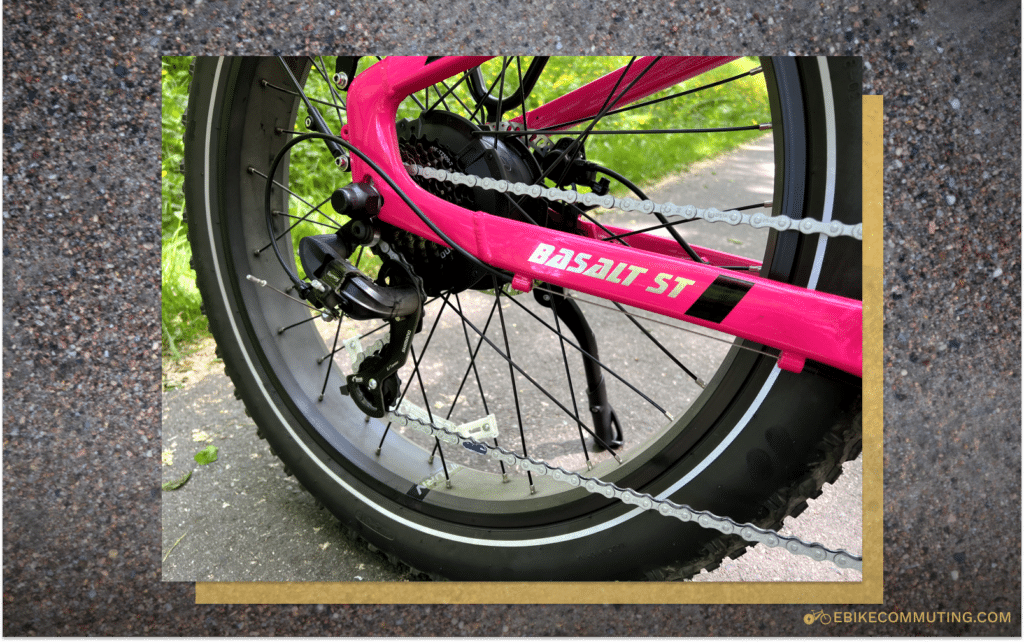
One aspect I assess in all e-bikes I test is the cadence-to-speed ratio, which determines the pedaling speed needed to maintain a certain velocity. For the Basalt ST e-bike, a reasonable cadence was necessary to reach the higher speeds advertised.
To maintain a speed of 15 miles per hour, a cadence of 55 was sufficient. This was in the seventh gear, allowing room for you to downshift for a higher cadence, if preferred.
To reach 20 miles per hour, a cadence of approximately 70 rpm was needed, which is quite comfortable. To achieve the advertised top speed of 28 miles per hour, a cadence of 100 rpm was required.
Reaching 100 rpm might cause the bike to wobble slightly and isn’t sustainable for prolonged periods. However, it was convenient to achieve this speed on straight paths when I needed to get home quickly after running errands.
Now, let’s talk about torque. As mentioned earlier the Mokwheel has 90 Nm of torque. I generally group e-bikes into three categories when it comes to torque and the Basalt ST is in that highest category of over 60 Nm, which means it’s really good at climbing hills.

I’ve begun to include a hill climb test in every e-bike review. The hill isn’t very long, only half a mile with about 200 feet of climbing. It has an average grade of eight and a half percent, but it increases to about 11 or 11 and a half percent towards the end. The e-bike handled it with ease. I completed the climb in two and a half minutes, maintaining a comfortable average cadence of 70. As I neared the steeper part of the hill, I had to downshift slightly, but overall, the ride was incredibly smooth. I powered up the hill effortlessly and wasn’t even out of breath by the end, which speaks volumes about the motor and torque of this e-bike. Despite being a heavy e-bike, its power and torque compensates for its weight, making it a great option for climbing.
Regarding torque, I appreciate the inclusion of a torque sensor. This feature applies power as you pedal, unlike a cadence sensor. I find that torque sensors deliver power more evenly and naturally, providing a more natural acceleration feel, which I find enjoyable.
Another feature I appreciated is the throttle. Not all e-bikes include this function, which is very useful for quickly crossing intersections or accelerating from a stop sign on a hill. The throttle only provides power up to 20 miles per hour. Beyond this speed, the bike relies on the torque sensor to reach up to 28 miles per hour, so you need to pedal to achieve this speed.
The thumb throttle is located on the left hand side of the handlebars, next to the buttons to adjust the pedal assist levels.
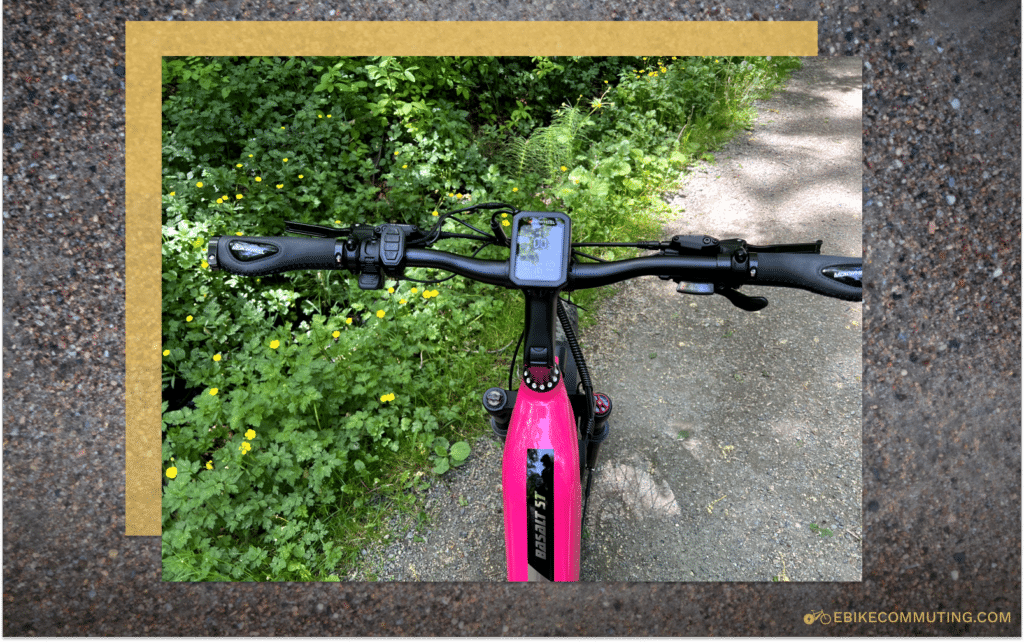
Interestingly, Mokwheel labels the Basalt ST as a class 2 e-bike, even featuring a class 2 sticker on the frame. However, it has a throttle that provides power up to 28 miles per hour, technically categorizing it as a class 3 e-bike. I don’t like that this e-bike is mislabeled as a Class 2.
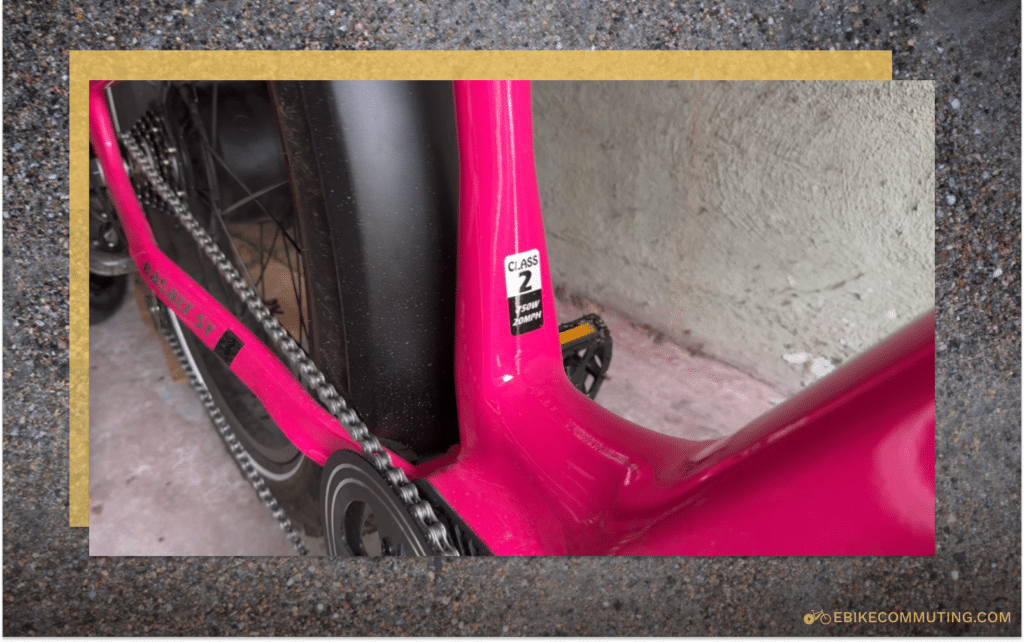
I tested the Basalt ST under various conditions, and its broad tires handled everything excellently. I rode it on both wet and dry gravel, wet and dry pavement, and the tires consistently provided stability and comfort. It also has excellent rain fenders that provide ample coverage both on the front and back wheel.
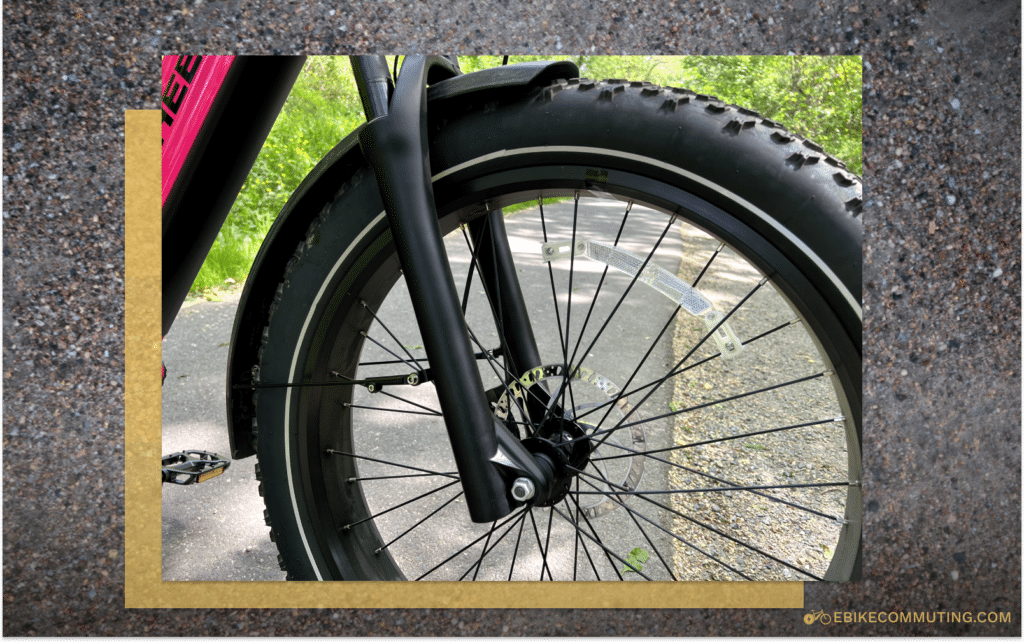
The bike is designed with a front suspension system which effectively absorbs shocks. This, combined with those big fat tires, and a plush comfy seat made for a very pleasant and comfortable riding experience.

One feature that Mokwheel emphasizes about the Basalt ST is its large battery. It advertises a range of 60 to 80 miles. While I didn’t ride it that far, it certainly felt capable of approaching that range if one were to use lower pedal assist levels. The battery is well integrated into the step thru frame giving the Basalt ST a nice clean look. Plus, it was easy to remove for charging.
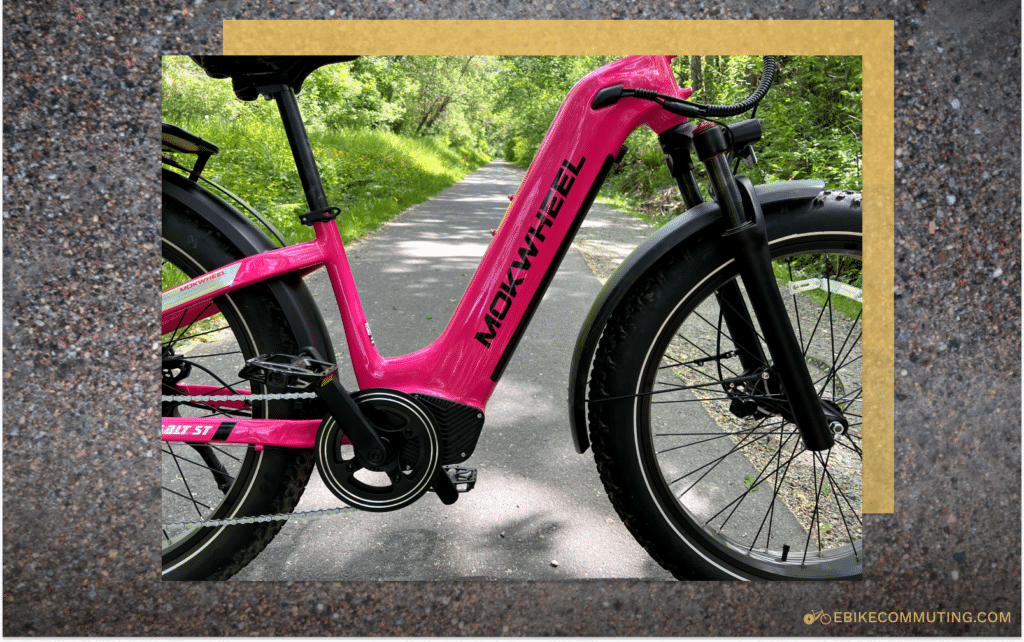
One more thing that I liked about the Basalt ST was the wood or bamboo accent on the rear rack. It added a bit of sophistication and warmth to the e-bike that I found pleasant.

Now, let’s discuss a few areas where the Basalt ST fell short, starting with the build quality and attention to detail. There were several issues that gave me pause during the assembly and initial rides.
Firstly, the headset spacer was backwards. According to the instructions, the bolts should be on the backside during assembly, but in the accompanying picture, they were on the front side. This discrepancy between instructions and visuals indicates a lack of attention to detail, although it’s not a major issue.
Another problem I encountered involved the crank arm. During a ride, I noticed that my foot felt loose or wobbly on the pedal while pedaling. Initially, I suspected that I hadn’t tightened the pedal correctly. However, upon inspection, I found that the bolt securing the crank arm was loose. It was so loose, in fact, that it wobbled back and forth and was close to falling off. This discovery was frustrating, as I was miles away from home without the necessary tools to tighten it. Fortunately, the Mokwheel features a throttle, which I heavily relied on for the rest of the ride to limit pedaling.
While the manual likely advises you to check every bolt before your first ride and provides tools for assembly, it did not include a tool that fit the crank arm bolt. Therefore, it’s essential to have your own tools and thoroughly check every bolt when assembling this e-bike.
Concerning the fit of the Basalt ST, I found Mokwheel’s recommended rider height ranges to be inaccurate. Their website indicates that the “Normal” size can accommodate a person who is 6’4″. However, at 6’2″, when I extended the seat post to its maximum marked height, the e-bike felt too small, resulting in a cramped feeling when pedaling. This seems like a relatively simple issue for Mokwheel to correct, so it’s surprising that their website provides incorrect ranges.
While riding the Basalt ST a couple of times, the e-bike motor and display randomly turned off, indicating a “battery error” on the display. This issue typically lasted for about 10 seconds. The exact cause remains unclear. This incident also occurred during my first ride. Initially, I thought the battery might not have been secured tightly enough in the compartment, but I don’t think that was the issue, unclear what actually caused it.

Another area where I found it lacking is that it doesn’t come with a bell, but instead has a horn. I’ve found the horn to be ineffective on multi-use bike and pedestrian paths. People usually associate horns with cars and angry motorists. When I honk the horn, pedestrians usually jump in fright or give me a rude look as I pass.
The display is packed with useful information, but it lacks a remaining range estimation. There are indicators on the left and right that show the battery level. However, I noticed that when the battery level dropped to about a third, it depleted quite rapidly. I once set out with what seemed like a third of the battery left according to the indicator, but the level quickly turned red and started to flash, indicating a low battery level. A range estimator would be a helpful addition, informing me, for instance, that I only have five miles left.
So, that’s the Mokwheel Basalt ST. This is a good entry-level fat-tire e-bike for those looking for speed and the ability to take on any climb on their commute.
